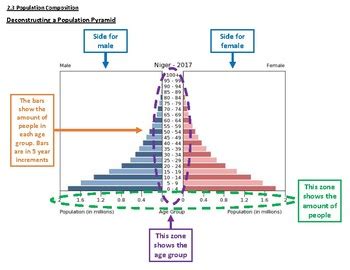Understanding Dependency Ratio
The dependency ratio is a measure of the proportion of people in a population who are not of working age (typically 15-64 years) relative to those who are. It is calculated by dividing the number of dependents (children under 15 and adults over 64) by the number of working-age adults.

Key Terms
- Total dependency ratio: Includes both child and elderly dependents.
- Child dependency ratio: Measures the number of children under 15 per 100 working-age adults.
- Elderly dependency ratio: Measures the number of adults over 64 per 100 working-age adults.
Importance in AP Human Geography
The dependency ratio is an important indicator of a country’s economic and social well-being. It has significant implications for:
- Economic growth: High dependency ratios can strain resources and reduce investment in infrastructure and education.
- Workforce participation: As the elderly population grows, the size of the labor force may decrease, impacting productivity and economic growth.
- Social welfare: Dependency ratios influence the need for social services, such as healthcare, education, and support for the elderly.
Global Trends
Globally, the total dependency ratio has been declining due to falling fertility rates and increasing longevity. However, the elderly dependency ratio is rising as life expectancy increases. The World Bank estimates that by 2050, the global elderly dependency ratio will increase from 25% to 49%.
By Country
Dependency ratios vary significantly by country. In developed countries, low fertility rates and an aging population have resulted in high dependency ratios. In contrast, many developing countries have high child dependency ratios due to higher fertility rates.
Table 1: Dependency Ratios by Region (2020)
| Region | Total Dependency Ratio | Child Dependency Ratio | Elderly Dependency Ratio |
|---|---|---|---|
| East Asia & Pacific | 45.5% | 22.8% | 22.7% |
| Europe & Central Asia | 50.4% | 16.3% | 34.1% |
| Latin America & Caribbean | 50.2% | 25.2% | 25.0% |
| Middle East & North Africa | 61.4% | 36.1% | 25.3% |
| North America | 59.1% | 17.2% | 41.9% |
| South Asia | 60.5% | 34.9% | 25.6% |
| Sub-Saharan Africa | 85.1% | 46.3% | 38.8% |
Economic and Social Implications
Economic implications:
- Labor costs: High dependency ratios can increase labor costs due to the need for more workers to support dependents.
- Productivity: An aging workforce may result in a decline in productivity due to reduced physical capabilities and healthcare expenses.
- Fiscal pressures: Governments face fiscal pressures from rising healthcare, pension, and social welfare costs associated with an aging population.
Social implications:
- Intergenerational equity: High dependency ratios can raise concerns about intergenerational equity, as younger generations may bear the burden of supporting a growing elderly population.
- Caregiving: Aging parents often require caregiving by their children, which can impact their work and family life.
- Social isolation: Elderly people may experience social isolation due to limited mobility and a lack of peers.
Strategies to Address Dependency Ratios
- Increasing fertility rates: Policies that encourage childbearing, such as paid parental leave and childcare subsidies, can help increase child dependency ratios.
- Raising the retirement age: Increasing the age at which people are eligible for retirement can reduce elderly dependency ratios.
- Promoting workforce participation: Policies that support older workers, such as flexible work arrangements and job retraining, can keep them in the labor force longer.
- Investing in healthcare: Investments in healthcare can extend life expectancy and reduce the economic burden of caring for an aging population.
- Supporting intergenerational caregiving: Programs that support intergenerational caregiving, such as respite care and financial assistance, can ease the burden on families.
Common Mistakes to Avoid
- Confusing dependency ratio with population growth rate: The dependency ratio measures the age structure of a population, while the population growth rate measures the rate at which the population is increasing or decreasing.
- Assuming a high dependency ratio is always negative: High dependency ratios can have both positive and negative implications. For example, they may indicate a healthy birth rate or a long life expectancy.
- Making generalizations based on total dependency ratio only: The total dependency ratio does not account for the different needs of children and elderly dependents. Child and elderly dependency ratios provide more specific insights.
Pros and Cons of High and Low Dependency Ratios
High Dependency Ratios:
-
Pros:
- Potential for economic growth with a large labor force (if employed).
- High social cohesion due to strong family connections.
-
Cons:
- Economic strain from supporting a large number of dependents.
- Reduced government resources for infrastructure and education.
Low Dependency Ratios:
-
Pros:
- Higher economic productivity with a smaller number of dependents.
- Reduced fiscal pressures on governments.
-
Cons:
- Concerns about intergenerational equity.
- Potential for labor shortages.
Conclusion
The dependency ratio is a valuable tool for understanding the age structure and economic and social implications of population change. By analyzing dependency ratios, policymakers can develop strategies to address the challenges and opportunities facing societies with aging populations.
